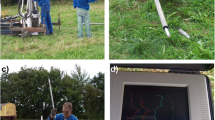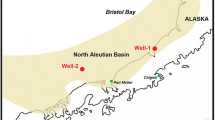Abstract
In the paper, a novel inversion approach is used for the solution of the problem of factor analysis. The float-encoded genetic algorithm as a global optimization method is implemented to extract factor variables using open-hole logging data. The suggested statistical workflow is used to give a reliable estimate for not only the factors but also the related petrophysical properties in hydrocarbon formations. In the first step, the factor loadings and scores are estimated by Jöreskog’s fast approximate method, which are gradually improved by the genetic algorithm. The forward problem is solved to calculate wireline logs directly from the factor scores. In each generation, the observed and calculated well logs are compared to update the factor population. During the genetic algorithm run, the average fitness of factor populations is maximized to give the best fit between the observed and theoretical data. By using the empirical relation between the first factor and formation shaliness, the shale volume is estimated along the borehole. Permeability as a derived quantity also correlates with the first factor, which allows its determination from an independent source. The estimation results agree well with those of independent deterministic modeling and core measurements. Case studies from Hungary and the USA demonstrate the feasibility of the global optimization based factor analysis, which provides a useful tool for improved reservoir characterization.










Similar content being viewed by others
References
Akça I, Basokur AT (2010) Extraction of structure-based geoelectric models by hybrid genetic algorithms. Geophysics 75:F15–F22
Alvarez JPF, Martínez JLF, Pérez COM (2008) Feasibility analysis of the use of binary genetic algorithms as importance samplers application to a 1-D DC resistivity inverse problem. Math Geosci 40:375–408
Asfahani J (2014) Statistical factor analysis technique for characterizing basalt through interpreting nuclear and electrical well logging data (case study from Southern Syria). Appl Radiat Isot 84:33–39
Bartlett MS (1937) The statistical conception of mental factors. Br J Psychol 28:97–104
Basilevsky A (1994) Statistical factor analysis and related methods: theory and applications. John Wiley & Sons, Hoboken, pp 367–381
Bóna A, Slawinski MA, Smith P (2009) Ray tracing by simulated annealing: bending method. Geophysics 74:T25–T32
Boschetti F, Dentith MC, List RD (1996) Inversion of seismic refraction data using genetic algorithms. Geophysics 61:1715–1727
Changchun Y, Hodges G (2007) Simulated annealing for airborne EM inversion. Geophysics 72:F189–F195
Cranganu C, Luchian H, Breaban ME (2015) Artificial intelligent approaches in petroleum geosciences. Springer International Publishing, Switzerland
Dobróka M, Szabó NP (2011) Interval inversion of well-logging data for objective determination of textural parameters. Acta Geophys 59:907–934
Dobróka M, Szabó NP (2012) Interval inversion of well-logging data for automatic determination of formation boundaries by using a float-encoded genetic algorithm. J Pet Sci Eng 86–87:144–152
Dobróka M, Szabó NP, Tóth J, Vass P (2016) Interval inversion approach for an improved interpretation of well logs. Geophysics 81:D163–D175
Dorrington KP, Link CA (2004) Genetic-algorithm/neural-network approach to seismic attribute selection for well-log prediction. Geophysics 69:212–221
Fang Z, Yang D (2015) Inversion of reservoir porosity, saturation, and permeability based on a robust hybrid genetic algorithm. Geophysics 80:R265–R280
Gryc G (1988) Geology and exploration of the National Petroleum Reserve in Alaska, 1974 to 1982. US Geol Surv Prof Pap 1399:1–940
Holland JH (1975) Adaptation in natural and artificial systems. University of Michigan Press, Ann Arbor
Houck CR, Joines J, Kay M (1995) A genetic algorithm for function optimization: a Matlab implementation. In: NCSU-IE technical report 95-09. North Carolina State University, Raleigh, pp 1–14
Jöreskog KG (2007) Factor analysis and its extensions. In: Cudeck R, MacCallum RC (eds) Factor analysis at 100, historical developments and future directions. Lawrence Erlbaum Associates, Mahwah, pp 47–77
Kaiser HF (1958) The varimax criterion for analytical rotation in factor analysis. Psychometrika 23:187–200
Keprt A, Snášel V (2005) Binary factor analysis with genetic algorithms. In: Abraham A, Dote Y, Furuhashi T, Köppen M, Ohuchi A, Ohsawa (eds) Soft computing as transdisciplinary science and technology. Proceedings of the fourth IEEE International workshop WSTST’05. Springer, Berlin, pp 1259–1268
Larionov VV (1969) Radiometry of boreholes. Nedra, Moscow (in Russian)
Lawley DN, Maxwell AE (1962) Factor analysis as a statistical method. The Statistician 12:209–229
Menke W (1984) Geophysical data analysis: discrete inverse theory. Academic Press, New York
Michalewicz Z (1992) Genetic algorithms + data structures = evolution programs. Springer, New York
Michalski A (2013) Global optimization: theory, developments and applications. In: Mathematics research developments. Computational mathematics and analysis series. Nova Science Publishers, New York
Puskarczyk E, Jarzyna J, Porebski Sz (2015) Application of multivariate statistical methods for characterizing heterolithic reservoirs based on wireline logs—example from the Carpathian Foredeep Basin (Middle Miocene, SE Poland). Geol Q 59:157–168
Rao BN, Pal PC (1980) Factor analysis for interpreting petrophysical data on Roro ultramafics, Singhbhum district, India. Geophys Prospect 28:112–118
Sen MK, Bhattacharya BB, Stoffa PL (1993) Nonlinear inversion of resistivity sounding data. Geophysics 58:496–507
Sen MK, Stoffa PL (2013) Global optimization methods in geophysical inversion. Cambridge University Press, Cambridge
Spearman C (1904) The proof and measurement of association between two things. Am J Psychol 15:72–101
Steiner F (1991) The most frequent value: introduction to a modern conception of statistics. Academic Press, Budapest
Szabó NP (2011) Shale volume estimation based on the factor analysis of well-logging data. Acta Geophys 59:935–953
Szabó NP, Dobróka M (2013) Extending the application of a shale volume estimation formula derived from factor analysis of wireline logging data. Math Geosci 45:837–850
Szabó NP, Balogh GP (2016) Most frequent value based factor analysis of engineering geophysical sounding logs. In: 78th EAGE conference and exhibition, paper Tu SBT4 12. Vienna, pp 1–5
Szabó NP, Dobróka M (2017) Robust estimation of reservoir shaliness by iteratively reweighted factor analysis. Geophysics 82:D69–D83
Timur A (1968) An investigation of permeability, porosity, and residual water saturation relationship for sandstone reservoirs. Log Anal 9:8–17
USGS (1999) Selected data from eleven wildcat wells in the national petroleum reserve in Alaska. In: USGS open file report 99–015. https://pubs.usgs.gov/of/1999/ofr-99-0015/ofr-99-0015.html
Yang H, Bozdogan H (2011) Learning factor patterns in exploratory factor analysis using the genetic algorithm and information complexity as the fitness function. J Pattern Recognit Res 6:307–326
Acknowledgements
This research was supported by the GINOP-2.3.2-15-2016-00010 “Development of enhanced engineering methods with the aim at utilization of subterranean energy resources” project in the framework of the Széchenyi 2020 Plan, funded by the European Union, cofinanced by the European Structural and Investment Funds. The first author thanks the support of the GINOP project. The research was partly supported by the National Research Development and Innovation Office (Project No. K109441), and as the leader of the project, the second author thanks the Office for its support. Both authors thank the Geokomplex Ltd. for providing well logs and grain-size data from Well-3.
Author information
Authors and Affiliations
Corresponding author
Rights and permissions
About this article
Cite this article
Szabó, N.P., Dobróka, M. Exploratory Factor Analysis of Wireline Logs Using a Float-Encoded Genetic Algorithm. Math Geosci 50, 317–335 (2018). https://doi.org/10.1007/s11004-017-9714-x
Received:
Accepted:
Published:
Issue Date:
DOI: https://doi.org/10.1007/s11004-017-9714-x




